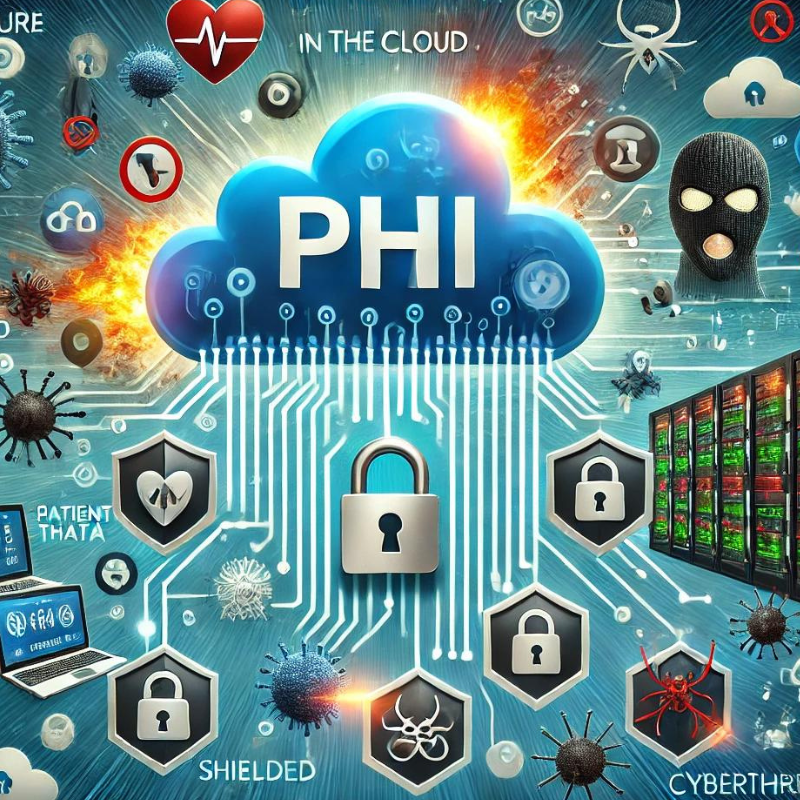5 Ways Healthcare Cloud Threat Intelligence Can Prevent Data Breaches
The healthcare sector stands as one of the most targeted industries for cyberattacks. The sensitive nature of Protected Health Information (PHI) and Personally Identifiable Information (PII) makes healthcare data a prime target for cybercriminals.
Just as a seasoned warrior doesn’t venture into combat without armor and strategy, healthcare providers must equip themselves with robust threat intelligence to fend off attacks. Imagine entering this digital battlefield fully armed—not just with shields to defend, but with the sharpest swords of proactive threat detection. As the saying goes, a strong offense is the best defense. By harnessing advanced cloud threat intelligence, healthcare organizations can anticipate enemy moves, identify vulnerabilities before they are exploited, and effectively safeguard their most valuable assets: patient trust and data integrity.
Impact of Cybersecurity Risks on Healthcare
The impact of these cybersecurity risks on the healthcare industry is profound. Data breaches can lead to financial losses, legal ramifications, and a decline in patient trust. The average cost of a healthcare breach is estimated at $9 million per incident, making it the most expensive industry for data breaches. The healthcare sector has continued to grapple with a surge in cyberattacks, with several high-profile incidents that underscore the critical need for fortified cybersecurity measures.
The recent cybersecurity breach at Change Healthcare that compromised the information of millions of individuals. The breach, which was caused by a vulnerability in one of the company’s IT systems, exposed sensitive data including names, birthdates, social security numbers, and medical diagnosis codes.
These incidents underscore the persistent danger of cyber-attacks in healthcare, prompting worries about the adequacy of security protocols safeguarding patient data. It is crucial to remember that it is the patients who bear the brunt, enduring stress and losing trust in the healthcare system.

Healthcare Cloud Threat Detection in Action
Healthcare breaches serve as a stark reminder of the critical importance of a proactive cybersecurity stance in safeguarding patient data. By bolstering threat detection capabilities and nurturing a culture of security awareness, organizations can effectively combat the escalating risks to healthcare data. It is imperative to view these breaches as valuable learning opportunities. Analyzing these incidents enables teams to gain insights into attackers’ tactics and enhance their healthcare cloud threat intelligence strategies. This proactive approach embodies the essence of threat intelligence in action.
Top Healthcare Cybersecurity Threats to Learn From:
- Ransomware Attacks: Ransomware attacks are on the rise, with cybercriminals encrypting critical data and demanding ransom payments for decryption keys. These attacks can cripple healthcare operations, delaying patient care and compromising sensitive data.
- Phishing: Phishing attacks, where attackers deceive users into divulging sensitive information, remain a significant threat. These attacks often target healthcare professionals through seemingly legitimate emails, leading to data breaches and unauthorized access.
- Malware: Malware, including viruses, trojans, and spyware, poses a constant threat to healthcare systems. Malware can infect devices, steal data, and disrupt operations, leading to potential data breaches and compromised patient care.
- Insider Threats: We often don’t think of internal threats when we think about cybersecurity risks. However, employees, contractors, and vendors with authorized access to healthcare systems can deliberately or unintentionally expose sensitive data. These insider threats can be hard to detect and may go unnoticed for extended periods, making them a major cybersecurity challenge in the healthcare industry. Insider threats, whether intentional or accidental, can lead to significant data breaches. Employees with access to sensitive information can misuse their privileges, leading to unauthorized data access and loss.
- Third-party Risk: Healthcare organizations often rely on third-party vendors for various services, increasing their risk exposure. These vendors may have access to sensitive data, making it critical to assess and mitigate any potential cybersecurity risks posed by these partnerships.
Essential Healthcare Cloud Threat Intelligence Strategies

- Implement Multi-Factor Authentication (MFA): Multi-Factor Authentication adds an additional layer of security by requiring multiple forms of verification before granting access to systems and data. This significantly reduces the risk of unauthorized access.
- Conduct Regular Security Training: Regular security training for healthcare professionals is essential. Educating staff about the latest threats and best practices helps create a security-aware culture within the organization.
- Use Advanced Threat Detection Tools: Deploying advanced threat detection tools such as Security Information and Event Management (SIEM) systems can help identify and respond to threats in real-time. These tools provide comprehensive monitoring and analysis of security events.
- Regularly Update and Patch Systems: Keeping systems and software up-to-date with the latest patches is crucial in addressing vulnerabilities. Regular updates help protect against known exploits and reduce the risk of attacks.
- Encrypt Sensitive Data: Encrypting sensitive data, both at rest and in transit, ensures that even if data is intercepted, it remains unreadable to unauthorized individuals.
Healthcare Cloud Threat Intelligence Can Benefit Your Business
- Real-Time Threat Detection: Healthcare Threat Intelligence leverages advanced analytics and machine learning capabilities to monitor network traffic and identify potential threats in real-time.
- Proactive Risk Mitigation: By continuously monitoring for potential vulnerabilities, healthcare cloud threat intelligence can help organizations proactively address risks before they are exploited by cybercriminals.
- Enhanced Security Awareness: Regular threat reports and training from healthcare cloud threat intelligence providers can increase security awareness among healthcare professionals, making them better equipped to identify and respond to potential threats.
- Improved Regulatory Compliance: Healthcare cloud threat intelligence provides comprehensive security measures that align with regulatory standards, ensuring compliance and avoiding fines or penalties.
- Cost-Effective Solutions: Implementing robust cybersecurity measures can be costly for healthcare organizations. Healthcare cloud threat intelligence offers cost-effective solutions, reducing the financial burden
Recommendations for Staying Up-to-Date with Cybersecurity Best Practices
Continuous Monitoring and Updates
Healthcare organizations should continuously monitor their cybersecurity posture and stay informed about the latest threats and vulnerabilities. Regular updates and patches are essential in maintaining a secure environment.
Collaborative Security Efforts
Collaboration with other healthcare providers and cybersecurity experts enhances threat intelligence and helps organizations stay ahead of emerging threats. Sharing best practices and insights fosters a collective approach to security.
Invest in Advanced Security Solutions
Investing in advanced security solutions such as MDR services, SIEM systems, and endpoint protection tools ensures comprehensive coverage against a wide range of cyber threats. These solutions provide robust protection and rapid response capabilities.
Looking Ahead
By harnessing advanced cloud threat intelligence strategies, healthcare organizations can anticipate enemy moves, identify vulnerabilities before they are exploited, and effectively safeguard their most valuable assets: patient trust and data integrity. As the stakes continue to rise, so too must the resolve to defend against cyber adversaries with vigilance and precision.
Investing in the right tools and strategies ensures not only compliance with stringent regulations but also the preservation of the healthcare sector’s most sacred duty—protecting patients.
Ready to elevate your healthcare cloud security intelligence? Schedule a free Cloud Risk Checkup today. You’ll receive a tailored Cloud Risk Report that establishes a baseline assessment of your risk levels in accordance with standards such as HIPAA, HITRUST, NIST, and ISO27001.
Curious to learn more? Explore ClearDATA Managed Detection and Response solutions specifically designed for healthcare.
FAQ
What is healthcare cloud threat intelligence?
Healthcare cloud threat intelligence refers to the process of gathering, analyzing, and interpreting data about potential cybersecurity threats targeting cloud environments used in the healthcare sector. This intelligence provides insights into emerging threats, attack vectors, and vulnerabilities that could impact cloud-based healthcare systems. It enables healthcare organizations to anticipate and mitigate potential cyber risks before they can cause harm.
How does threat intelligence help prevent data breaches in healthcare?
- Threat intelligence can help prevent data breaches in healthcare by offering actionable insights into potential threats and vulnerabilities. By leveraging threat intelligence, healthcare organizations can:
- Identify Vulnerabilities: Detect and address weaknesses in their cloud infrastructure before they can be exploited by attackers.
- Proactive Threat Mitigation: Implement security measures based on the latest threat data to prevent attacks.
- Rapid Detection and Response: Quickly identify and respond to suspicious activities, minimizing the impact of potential breaches.
- Compliance with Regulations: Ensure that security practices align with regulatory requirements, reducing the risk of non-compliance-related breaches.
What are the best threat intelligence tools for healthcare cloud security?
Some threat intelligence tools for healthcare cloud security include but are not limited to:
- Security Information and Event Management (SIEM) Systems: These tools collect, analyze, and correlate security logs from various sources to provide a comprehensive view of the threat landscape.
- Next-Generation Endpoint Protection: Tools that actively monitor and protect cloud servers from threats, such as advanced malware and sophisticated cyberattacks.
- Vulnerability Scanning Tools: These tools identify and prioritize vulnerabilities across cloud environments, helping organizations address potential risks proactively.
- Threat Intelligence Platforms: Solutions that aggregate and analyze threat data from diverse sources, offering actionable insights to enhance security measures.
Ready to elevate your healthcare cloud security intelligence?



